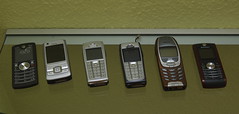There is a pattern which happens sometimes which we can call “fighting last year’s battle.” It occurs when our sense of identity as individuals or as an organization is built on having a specific opposition but the situation has changed such that our former opposition is no longer our largest existential threat.
I’ll give you a well known example: The case of Yahoo, Flicker, Google and Facebook.
At one point in history Yahoo was one of the major powerhouses of the internet. It attracted money and talented engineers. Along the way Yahoo made the unfortunate decision to settle on their patent dispute with Google over the keyword auction advertising system. Google then used this concept to bury Yahoo in terms of attracting money and talent.

These events occurred as part of the closing days of Web 1.0. This was the web driven by documents, web pages. The primary difficulty of Web 1.0 was one of information overload. Google’s solution to this problem was to improve search. Yahoo’s solution to this problem was to improve curated directories.
As it turned out the curated directory, relying on human time, is not something which scales well and Yahoo lost that battle. The “good enough” of the search engine was deemed more valuable than the “quality curation” provided by Yahoo.
That battle was over.
But Yahoo wasn’t ready to give up. On the horizon was “video and images” and it was going to be the next big thing. Broadband was revving up and Yahoo, presuming that this new wealth of content would re-open the battle for solving the information overload problem bought the most popular image platform at the time: Flickr.

Flickr not only had a wealth of images but many of those images carried metadata–tags and other bits of information which put the images in context with the world and signified human meaning. Yahoo intended to use those tags to re-open the battle of Web 1.0 over the newly popular document formats of photos. Yahoo was going to bury their enemy Google.
But they didn’t. Because the battle for Web 1.0 was last year’s battle. Yes images and video were new and important. But while these new formats presented different challenges from text documents they weren’t altogether unique.
The next battle was social. Web 2.0 was going to get everyone connected to everyone else and “graph” these connections for the benefit of advertisers and other interested parties.

Yahoo went full steam ahead fighting their old existential threat Google. As a result Yahoo was ill prepared for the shift to a social web and along the way squandered many of the resources it could have used to compete (Flickr had nearly all of the features that Facebook has today, Yahoo had several group technologies which were best in class, Yahoo was the starting point for a wide array of web users).
Yahoo squandered their resources fighting a specific threat–their nemesis Google–and missed the change in the entire environment of the internet–Web 2.0.

The resulting collapse is now well known. Google became a more prestigious place for talented people to work. Yahoo, unable to innovate, spent years wandering in the wilderness messing around with a failing business model, not innovating and under the guidance of failed leadership.
Hindsight is always 20/20. It’s easy to pick on Yahoo for turning two of the most promising and loved internet services of their day–Flickr and Delicio.us–into abandonware.
But there are some deeper lessons on the nature of competition and change embedded in this web history:
- Understand the difference between specific threats and changes to competitive environment.
- The real danger of a nemesis is that they control our focus long after they cease to be the most important threat.
- We have available to us many resources and may not understand where their true value lies.
